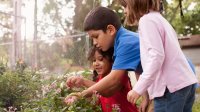Bringing the Natural World To Students With a Pollinator Garden
A garden for bees and butterflies helps local endangered species while providing opportunities for standards-based science lessons.
Your content has been saved!
Go to My Saved Content.Outdoor education is becoming more popular as educators look to provide authentic, nature-centered learning experiences outside the classroom. Pollinator gardens, which are designed to include flowers that provide pollen and nectar for pollinating insects, are one way educators can help endangered species in their schoolyards and communities while creating standards-based lessons for students.
The thought of trying to start such a garden, especially now, may seem overwhelming for any educator—and unfortunately, there’s no guarantee of success.
Nonetheless, now is an ideal time to begin planning, and with a little bit of research ahead of time you can improve your garden’s chances for when students eventually return.
Work Out the Logistics
Before getting into the specifics of what you will plant in your pollinator garden, it’s important to work through logistical considerations. Do you have prior approval from the building’s decision-makers? Do you have a designated outdoor location available? What about a budget? How will the garden be maintained throughout the year?
There are several step-by-step guides available online to help you answer these concerns early on, including the U.S. Fish and Wildlife Service’s Schoolyard Habitat Project Guide and Project Pollinator Guide. You might also check with your state agency in charge of parks, wildlife, and conservation.
Keep in mind that a garden can be as large or as small as you need it to be—raised garden beds, potted plants, and window boxes all count. You can spend as little as $30 or as much as $3,000. Keep in mind that, depending on your current situation and goals, you can always start small and expand in the future.
Research Local Pollinators Using Citizen Science
Once you have a general idea of the logistics, you may wish to consider the types of pollinators you would like to attract. This important step ensures a higher probability of success in terms of attracting a large and diverse population of native species.
In theory, the plants chosen for a pollinator garden should be those that are most valuable for the local species. Before that can be determined, you must research which species are most likely to be found in the area, and possibly which species are in decline and may benefit most from the planting of the garden. But where might one find that type of information?
Data contributed by nonprofessional citizen scientists is now widely accessible to the public through multiple online sites. Two such sites, iNaturalist and Butterflies and Moths of North America (BAMONA), provide comprehensive databases that are easy to use and are searchable by location.
When performing a search, the following points are worth keeping in mind.
Determine your goal: Is it to attract as many pollinators as possible or to bring back a species in decline?
If your goal is to attract many pollinators, search using a broad term such as “butterflies” or “bees.” Both sites present a list and map of verified sightings. iNaturalist will provide specific counts for each species within a given area. Take note of any species listed more frequently than others.
If your goal is to help a declining species, you have the option of completing searches within certain time perimeters. Look for species that have declined in number.
For those more inclined to go deeper, you might also search by specific families (such as family Papilionidae) or species (monarch) using either scientific or common names.
Select Appropriate Plants
After completing your species search, you will likely have a better idea of the types of pollinators native to your area. With this information handy, you can begin to decide which plants to include in your garden.
Both iNaturalist and BAMONA list host plants for specific species. Pollinator.org also provides Ecoregional Planning Guides downloadable for free. Here are some possible additional considerations:
- How much space is available to plant?
- What is the amount of sun, water, and shade the area receives?
- Do the plants being considered appeal to multiple species (at life stages)?
- Are the plants native to the region? Like native pollinators, native plants are well-adapted to local climate, soils, and growing seasons, and help support the existing ecosystem.
- What are the soil characteristics?
- When are the growing seasons?
You might also get in touch with local resources and experts. Those working and volunteering at garden or nature centers are typically passionate about what they do and have a wealth of knowledge that they are often more than happy to share, especially for the sake of education or conservation.
Use Your Garden for Citizen Science
Along with utilizing local experts, consider involving students in the garden-design process. Depending on their age, students can assist with the final selection of plants, garden layout, and/or actual planting and maintenance. Encourage them to journal or record data during the process. Upon completion of the garden, creating or joining a citizen science initiative using kid-friendly apps enables the garden’s data to give back to the scientific world. Journey North, Project Noah, and iNaturalist all have ongoing projects involving pollinators.
In addition, you will likely find that your garden seamlessly supports your existing curriculum, whether it’s life cycles in elementary grades or soil chemistry and statistics at the secondary level.
Are your students currently learning from home? Consider having them participate in container gardening or compiling data from each neighborhood. Have them share virtually through videos, photos, and graphs, and compare pollinator populations using their own observations.
Creating a pollinator garden may seem daunting at first, but by taking small steps, doing a little research, and setting reasonable goals, you’ll find that the benefits are worth the effort.
